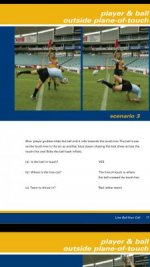OK,
This is an interesting one that I know at least 2 members on here that will be salivating over.
1st look at full speed:
Hard one to call today, but will be easy to call with new law trials for 2017.
The AR is in the best position (out of Ref and AR) to make a decision but doesn't, which is disappointing at that level (obviously scared the camera will show something he doesn't see). The AR moves in-goal but does not move quick enough to get best position (he could have) which is on the DBL. Had he been on the spot, he would have seen that the ball and the player carrying it were both over the line when his foot left the ground and he then released the ball.
The correct decision, and I believe that GJ gives the TMO a hint at what he's looking for, is that the player is in touch when he releases the ball.
If I was the referee, without replays or a TMO, I probably would have awarded the try because it would not have been clear and obvious to me, from where GJ was (or from where I might have been), that the player hadn't released the ball before lifting his foot or if he still carried the ball after lifting his foot.
I would have awarded the try and would have been wrong. In 2017, I would have been right.
2nd look with video (disregard the TMO's decision):
Player is in touch (which is what GJ hinted at) before releasing the ball.
Prediction:
This thread will go to at least 165 posts




